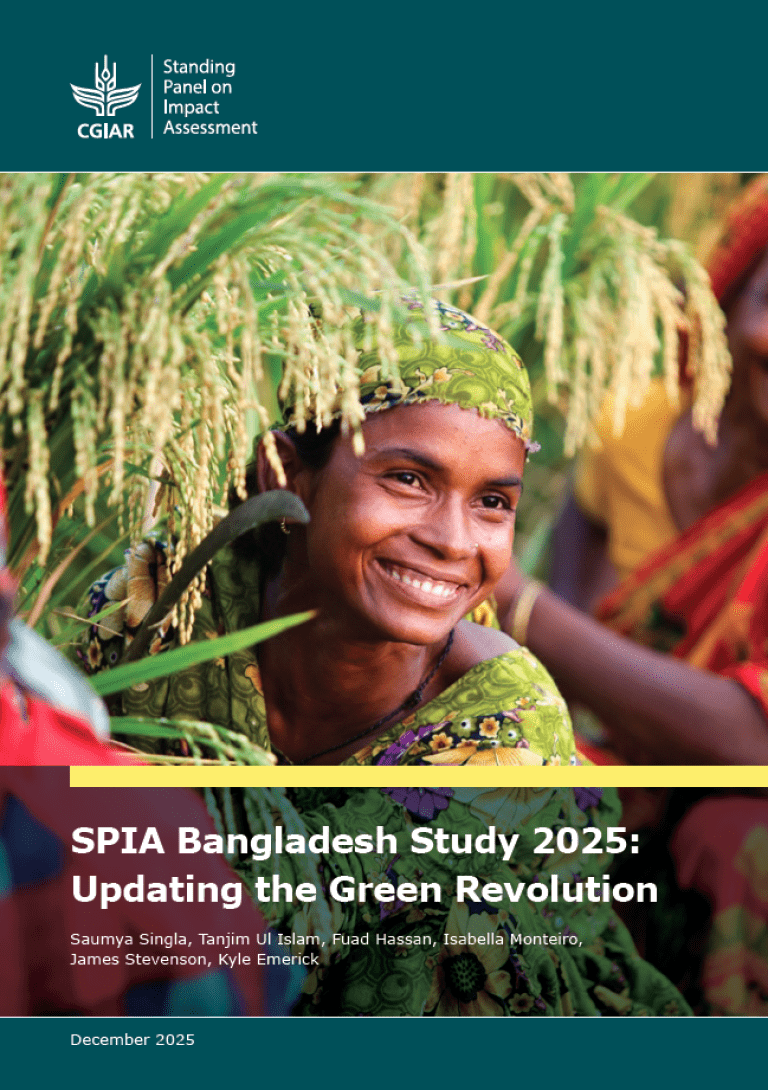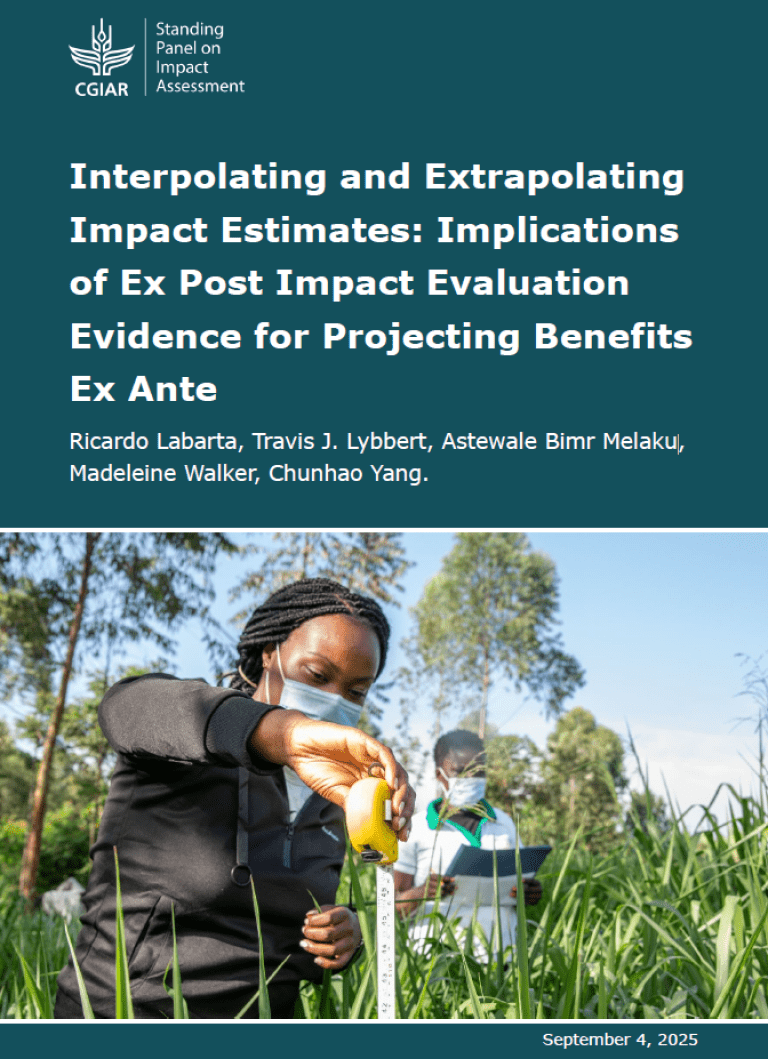2024 marks the end of a 6-year workplan for the CGIAR Standing Panel on Impact Assessment (SPIA). To share evidence generated through this workplan, SPIA organized a pre-conference workshop to the International Conference of Agricultural Economists in Delhi on 2 August. The workshop featured presentations on 9 overarching topics, including presentations of SPIA-funded studies, SPIA's own country-level work and external evidence with relevance for CGIAR. Microsummaries of the presented evidence are provided below.
PLENARY KEYNOTE: Impact Assessment for Agricultural in the Context of Structural Transformation
- Douglas Gollin opened the conference with a keynote speech focusing on the connection between agricultural impact assessment and models of structural change. He made the point that it is important to look at broader changes in structural transformation instead of just looking at shifts from agriculture into service or manufacturing industries. He further encouraged a focus on individuals’ well-being within the entire farm-household enterprise, rather than a narrow focus on increasing yields for specific crops. (Download PPT)
LONG-TERM LARGE-SCALE IMPACTS OF AGRICULTURAL INNOVATIONS
- A community-managed land restoration program in India showed significant ecological gains, but no consistent evidence that these biophysical improvements translated into significant socioeconomic benefits. (Karl Hughes, download PPT)
- In Bangladesh, dissemination and adoption of stress-tolerant rice varieties is increasing. However, yield impacts previously estimated using small scale experimental data cannot be replicated at the larger scale. (Jeffrey Michler, download PPT)
- Adoption of conservation agriculture in Mexico led to significant environmental benefits, including improved air quality and a reduction in infant mortality due to less agricultural burning. (Joel Ferguson, download PPT)
STRATEGIES FOR OVERCOMING CONSTRAINTS TO ADOPTION
- A study of interventions to promote small-scale mechanization in Ethiopia’s Oromia region found that training had modest effects on firm operations, while vouchers increased mechanized service usage by 30%, particularly among female-headed households. Labor reallocation among adults was minimal. (Susan Godlonton)
- A program linking farmers’ cooperatives with maize processors in Rwanda led to more land cultivation, increased input usage, and ultimately higher revenue, demonstrating the value of linking small farmers to larger value chains. (Shilpa Aggarwal)
- Exposure to new, sustainable input combinations through agronomic trials in Western Kenya influenced farmers’ learning and decision-making in heterogeneous ways. Skilled farmers adopted new inputs and practices faster, while low-skilled farmers lagged despite extended learning periods. (Rachid Laajaj, download PPT)
ETHIOPIA: A COUNTRY-LEVEL APPROACH
- New data from the SPIA Country-level study, gathered amid challenges like COVID-19, conflict, and drought, show that the reach of CGIAR-related innovations is growing, particularly in drought tolerant maize varieties. (Karen Macours)
- DNA fingerprinting evidence in Ethiopia shows that maize variety adoption has been consistent across regions, though genetic purity is decreasing. Farmers show high seed turnover, with 63% of households switching maize varieties between years, highlighting a dynamic adoption process. (Frederic Kosmowski)
- Geospatial evaluation of the Direct Seed Marketing initiative in Ethiopia shows increased yields especially for early adopters. (Johanne Pelletier/Travis Lybbert)
CLIMATE CHANGE ADAPTATION TECHNOLOGIES AND IMPACTS
- In irrigation systems in Mozambique, general feedback on water use proves as effective as individualized feedback, suggesting that simpler, less costly tools can address allocation issues efficiently. (Paul Christian, download PPT)
- A new tool offering long-range monsoon forecasts help farmers in India predict monsoon arrival. Good news increases cultivation and expenditure, but not necessarily profits. However, farmers still show a willingness to pay for forecasts, valuing the information despite modest profit changes. (Fiona Burlig, download PPT)
- Advances in data and computation now allow for the quantification of climate damages through data-driven models for different sectors, including agriculture. (Ashwin Rode, download PPT)
TARGETING AGRICULTURAL TECHNOLOGY FOR IMPACT
- Subsidies targeted at tube well owners in Bangladesh reduced electricity use in irrigation by 38% without affecting rice yields, but only in the first year. (Ujjayant Chakravorty, download PPT)
- Decentralizing demonstration plots in the Barisal district in Bangladesh, accelerated technology adoption in the short run without additional costs, supporting the idea that increasing the number of demonstrators is more effective than focusing on plot size or carefully selecting participants. (John Ashton Loeser)
- In testing varying subsidy levels for new agricultural technologies in Bangladesh, results show that higher subsidies increase adoption, but full subsidies do not significantly raise adoption among non-buyers. Free seed distribution increases adoption by 32 percentage points, indicating credit constraints rather than low expected returns as the barrier for non-buyers. (Mai Mahmoud, download PPT)
UGANDA: A COUNTRY-LEVEL APPROACH
- The SPIA country study in Uganda shows promising adoption figures for recent cassava releases, as well as groundnut varieties. The report suggests a need for innovative approaches, such as agroforestry, community breeding services, and conservation strategies, to build resilience in Uganda's farming communities. (James Stevenson)
- Long-term impacts of orange-fleshed sweet potato (OFSP) dissemination in Uganda shows that children exposed to OFSP dissemination when aged 0-2 or 0-5 experienced significant improvements in height-for-age (HAZ) and reduced morbidity. These results suggest substantial long-term benefits of biofortified crops on childhood health outcomes. (Julius Okello/Karen Macours)
- In the Ugandan bean seed system, genetic purity is a concern, with mixed varieties found throughout the supply chain. This highlights the need for stricter quality control, better management practices, and comprehensive monitoring to maintain seed quality. (Enid Katungi)
ENVIRONMENTAL IMPACTS OF INTENSIFICATION
- Analysis of a large-scale sorghum and millet intensification project in Mali’s Sikasso region revealed a decline in woody cover by 0.9% overall, with a 0.5% reduction within cropland and a 1.5% reduction outside cropland. This indicates a potential rebound effect linked to increased agricultural intensification. (Dilini Abeygunawardene, download PPT)
- In Punjab, India, conservation agriculture significantly curtails residue burning, saving thousands of hectares of land from burning. However, awareness among farmers remains low and current subsidies and R&D efforts are insufficient to drive widespread adoption. (Vijesh Krishna, download PPT)
- Contrary to concerns, Index-Based Livestock Insurance is found to have neutral to slightly positive impacts rangeland health in East African rangelands. (Christopher Barrett, download PPT)
AGRICULTURAL MECHANIZATION
- Mechanization in Indian agriculture, particularly in land preparation, significantly reduces female labor use by 2.4% per hectare, while having an insignificant effect on male labor. (Kanika Mahajan, download PPT)
- A study in India found that machine-harvestable chickpeas (MHCP) reduced harvesting costs, but constraints such as delayed availability and crop damage persisted. (Swamikannu Neduraman, download PPT)
- Mechanized Rice Transplanting (MRT) in rural India was shown to be valued more by women than by men, especially when involved in transplanting, reflecting their preference to reduce labor-intensive tasks. (Travis Lybbert, download PPT)
VIETNAM: A COUNTRY-LEVEL APPROACH
- The SPIA Country-level study in Vietnam provides insights into identification and scaling of innovations like genetically improved tilapia and sustainable farming practices, reflecting CGIAR’s extensive influence in Vietnam over the past two decades. (Frederic Kosmowski) (Preliminary report available here)
- The measurement of bundled innovation adoption presents significant challenges. In Vietnam, 1M5R measurements utilising objective criteria frequently yield divergent estimates, while self-reported data using package name lacks accuracy. (Thao Bach)
- Adjusted planting dates increased rice yield and profit in the Vietnamese Mekong Delta, particularly for fields within salinity barrier gates. (Dung Phuong Le)



